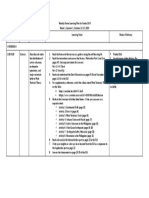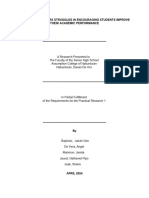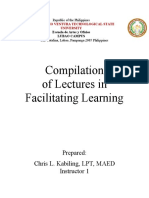DLL in Science
DLL in Science
Uploaded by
Arman Berina CortezCopyright:
Available Formats
DLL in Science
DLL in Science
Uploaded by
Arman Berina CortezOriginal Description:
Copyright
Available Formats
Share this document
Did you find this document useful?
Is this content inappropriate?
Copyright:
Available Formats
DLL in Science
DLL in Science
Uploaded by
Arman Berina CortezCopyright:
Available Formats
DAILY LESSON LOG IN SCIENCE GRADE __________
_________ Quarter SY. _____________
Day/Date: Monday /July 24, 2017 (sample) Teacher: _________________________________
I.OBJECTIVES
A. Content Standards The learners demonstrate understanding of different types of mixtures and
their characteristics.
B. Performance Standards The learners should be able to prepare beneficial and useful mixtures such
as drinks, food, and herbal medicines.
C. Learning competencies The learners should be able to describe the appearance and uses uniform
and non-uniform mixtures;
1. Cognitive
2. Psychomotor
3. Affective
II. CONTENT Topic: Mixture and their Characteristics Sub Topic:
III. LEARNING RESOURCES
A. REFERENCES
1. Teacher’s Guide Pages 2. Learner’s Materials Page 3. Textbook Pages
4. Additional Materials from LR Portal
B. Other Learning Resources
IV. PROCEDURES
A. Reviewing previews lesson or presenting the Teacher’s Instruction Picture Analysis. The teacher should
new lesson. show three pictures referring to solid, liquid and gas. Pictures
may be: a. wood (solid) b. water in a container (liquid) c. smoke
(gas) Guide Questions: 1. What can you observe/see in the
pictures given? 2. What could be the
B. Establishing a purpose to the lesson. What are the three physical states of matter and what do you
know about the three?
C. Presenting examples/instances of the new Teacher’s Instruction Solicit ideas of the student’s previous lesson by
lesson using the KWL chart on the three physical states of matter. Provide
Answer Sheets or let the students copy the format in their notebooks.
Let the students answer the first two columns : What you KNOW? and
What you WANT to know more?
D. Discussing new concepts and practicing new Direct Instruction. Teacher’s Concept: Matter is anything that occupies
skills # 1. space and has mass. The three physical states of matter are solid,
liquid and gas. Solids have definite volume and shape. Liquids have
definite volume but no definite shape and takes the shape of the
container. Gases have no definite shape and volume.
E. Discussing new concepts and practicing new
skills # 2.
Discussing new concepts and practicing new
skills # 3.
F. Developing Mastery
G. Finding practical application of concepts and
skills in daily living.
H. Making Generalization and Abstraction Teacher’s Instruction Concept Webbing. The teacher will ask the
about the lesson. students to give their summary of what they learned from the lesson.
Ask the students to attach it on the following diagram.
I. A .Evaluate Learning
B. Application Question: How can you make sense of the concept of the lesson in your real life context?. *
I. Additional activities for Application or Remediation
V. REMARKS
VI. REFLECTION
A. No. of learners who earned 80% in the Evaluation
B. No. learners who require additional activities for remediation who scored
below 80%
C. Did the remedial work? No. of learners who have caught up with the lesson
D. No. of learners who continue to require remediation
E. Which of my teaching strategies worked well? Why did this worked?
F. What difficulties did I encounter which my principal or superior can help me
solve?
G. What innovations or localized materials did I used/discovered which I wish
to share with other teachers?
Enriched Daily Lesson Log in Science Grades 1-12
I. Rationale
There is a need to enrich the Daily Lesson Log in Science in the Elementary,
Junior and Senior High School as prescribed by DepED Order No. 42 s. 2016 for the
following reasons:
A. to give emphasis on the task which science teachers should not miss in
unveiling the lesson for the day
B. to guide science teachers of the importance of the learning competency of
the day which has to be broken down into three (3) behavioral objectives
for the three domains namely one (1) Cognitive for the development of
Knowledge (Head), one (1) Psychomotor for the development of the
Process Skills (Body & Hands)and one (1) Affective for the development of
Scientific Attitudes and Values (Heart). This is in consonance with the 3
Skills-A-Day Program stipulated in the Division Memorandum No. 133 s.
2015 entitled Science Innovative Programs for Public and Private
Elementary and Secondary Schools as its legal basis. This is anchored on
both Bloom’s Taxonomy for effective teaching and on Vygotsky’s
Development of Higher Psychological Processes for the development of the
higher-order thinking skills. In this way, science teachers will work on the
holistic development of the learners including their Health. Hence, Science
Education works for the Development of Four (4) H’s, the Head, the Hands,
the Heart and Health of the learners. Relative to this, an Application
Question which follows right after the evaluation of learning, presented in
the form of the question, “How can you make sense of the scientific
concept (Lesson Content) in the real-life context/situation?” When do
you…….? How do you…….? etc. are follow-up questions to make the
learning experience more relevant and meaningful to the learners
C. to adopt an effective and efficient system of a dynamic teaching-learning
interaction in the classroom carried out by the science teachers as
facilitators of learning.
II. Description of the Template
A. Long bond paper (8.5x13) Portrait
B. Specific Objectives
1. Cognitive
2. Psychomotor
3. Affective
C. Application Question (How can you make sense of the scientific concept (Lesson
Content) in your real-life context/situation?
D. Daily Lesson Log Template for Science Teaching Learning Process (One Page per day)
III. Attachments
A. Enriched Daily Lesson Log in Science Template
B. Division Memorandum No. 133 s. 2015
You might also like
- Weekly Home Learning Plan ScienceDocument3 pagesWeekly Home Learning Plan SciencePatricia100% (24)
- Participate in Workplace CommunicationDocument8 pagesParticipate in Workplace CommunicationArman Berina CortezNo ratings yet
- DLL 3rd ObservationDocument5 pagesDLL 3rd ObservationDanilo Alburo100% (1)
- 7 E Lesson PlanDocument1 page7 E Lesson PlanDanilo Alburo100% (4)
- Curriculum DesignDocument15 pagesCurriculum Designahmed100% (6)
- STE Action Plan 2021-2022Document5 pagesSTE Action Plan 2021-2022Bernadette L. Macadangdang100% (1)
- Material Cycles-Lesson 5Document33 pagesMaterial Cycles-Lesson 5jamieprudhomme100% (2)
- EFDT Rate of Chem RXNDocument4 pagesEFDT Rate of Chem RXNvilmarNo ratings yet
- LOCALIZED INDIGENIZED INSTRUCTIONAL MATERIALS Science 8Document6 pagesLOCALIZED INDIGENIZED INSTRUCTIONAL MATERIALS Science 8joyce kris AlmacinNo ratings yet
- Central Dogma Lesson PlanDocument3 pagesCentral Dogma Lesson Planapi-307962259100% (2)
- Earthquake Drill Evaluation Form OCDDocument2 pagesEarthquake Drill Evaluation Form OCDArman Berina Cortez100% (3)
- Political Cartoons Lesson PlanDocument3 pagesPolitical Cartoons Lesson Planapi-256444300No ratings yet
- ANGELINADocument3 pagesANGELINAMichael Stephen Gracias100% (6)
- DLL - Science 6 - Q2 - W3Document5 pagesDLL - Science 6 - Q2 - W3Benjie Modelo ManilaNo ratings yet
- WHLP-WEEK 1 - Grade10 ScienceDocument1 pageWHLP-WEEK 1 - Grade10 ScienceLove Grace Davin80% (5)
- Biology Lesson ExemplarDocument4 pagesBiology Lesson ExemplarLin Giel0% (1)
- Science Lesson Plan April 1Document4 pagesScience Lesson Plan April 1api-283894138No ratings yet
- Performance TaskDocument2 pagesPerformance Taskapi-261880769100% (5)
- Action Plan in Special Science Elementary ClassDocument1 pageAction Plan in Special Science Elementary ClassKristel Nabor100% (1)
- History of Microscopes Lesson PlanDocument2 pagesHistory of Microscopes Lesson PlanSuresh Mg100% (1)
- Photosynthesis: Strategic Intervention Materials Science 9Document27 pagesPhotosynthesis: Strategic Intervention Materials Science 9juliusleo martin100% (2)
- Dec 2-7 Week 4 Grade 8 Science DLLDocument2 pagesDec 2-7 Week 4 Grade 8 Science DLLRicardo Acosta Subad100% (4)
- Integration of ValuesDocument7 pagesIntegration of Valuesapi-340406981No ratings yet
- Grade 8 ModulesDocument7 pagesGrade 8 ModulesnoyNo ratings yet
- School Teacher Teaching Date Teaching Time Lesso N Exemp LARDocument36 pagesSchool Teacher Teaching Date Teaching Time Lesso N Exemp LARRichard F. Talamera100% (1)
- Unit - Lesson Plan - Genotypes and PhenotypesDocument4 pagesUnit - Lesson Plan - Genotypes and PhenotypesShannuRRasheedNo ratings yet
- 1.3 Safety Guidelines and Introduction of ChemistryDocument5 pages1.3 Safety Guidelines and Introduction of ChemistryJanine DafunNo ratings yet
- Squashing The Bottle-Ideal Gas LawDocument1 pageSquashing The Bottle-Ideal Gas LawSarah Candelaria ArcellanaNo ratings yet
- Cot-Plan Science 8-FourthDocument6 pagesCot-Plan Science 8-FourthKristine A. LopezNo ratings yet
- Final Lesson Exemplar in Science 10Document9 pagesFinal Lesson Exemplar in Science 10Jundell C. Diaz100% (2)
- Performance Task 4Document4 pagesPerformance Task 4Kristine Mhe Balais100% (1)
- Grade 8 Activity Sheet Week 3 ScienceDocument3 pagesGrade 8 Activity Sheet Week 3 ScienceIvy Montecalvo100% (1)
- I. Objectives A. Content Standards: Monday Tuesday Wednesday Thursday FridayDocument8 pagesI. Objectives A. Content Standards: Monday Tuesday Wednesday Thursday FridayMaribel NayadNo ratings yet
- Demonstrates Understanding Of: Online Resource For Middle School Chemistry. Retrieved FromDocument7 pagesDemonstrates Understanding Of: Online Resource For Middle School Chemistry. Retrieved FromRenante CruzNo ratings yet
- Final Detailed Lesson Plan GatuzDocument14 pagesFinal Detailed Lesson Plan GatuzCarla Briones DionisioNo ratings yet
- Yes-O (Aar)Document2 pagesYes-O (Aar)Daiseree Salvador100% (2)
- 10.5 Modern Evidence of Evolution PDFDocument4 pages10.5 Modern Evidence of Evolution PDFAngela Foulger-RichardsonNo ratings yet
- Science 7 - Performance Task 2 - 3rd QuarterDocument1 pageScience 7 - Performance Task 2 - 3rd Quarteramaezingciel100% (1)
- Curriculum Guide: Instructional PlanningDocument6 pagesCurriculum Guide: Instructional PlanningJohn Perseus LeeNo ratings yet
- Daily Lesson Log Environmental ScienceDocument2 pagesDaily Lesson Log Environmental ScienceDiane Marr N. DencioNo ratings yet
- Lesson Plan For Grade 9 Science Quarter 1 Week 2Document3 pagesLesson Plan For Grade 9 Science Quarter 1 Week 2Windie M. BemidaNo ratings yet
- Lesson Log 7 (First Quarter)Document6 pagesLesson Log 7 (First Quarter)Maila Galimba Castillo90% (20)
- DLP 7e's For DEMODocument3 pagesDLP 7e's For DEMORamir BecoyNo ratings yet
- The Learner Shall Be Able To Develop A Writer Plan and Implement A "Newton's Olympics"Document3 pagesThe Learner Shall Be Able To Develop A Writer Plan and Implement A "Newton's Olympics"R-Yel Labrador Baguio100% (2)
- Q1 - Forces and Motion - Performance TaskDocument2 pagesQ1 - Forces and Motion - Performance TaskCharmalou Pampilo OgarteNo ratings yet
- Lesson PlanDocument5 pagesLesson Planapi-35319066375% (4)
- Curriculum Guide: Instructional PlanningDocument2 pagesCurriculum Guide: Instructional PlanningRitz Anton LimNo ratings yet
- Performance Task 1Document3 pagesPerformance Task 1Jellie May RomeroNo ratings yet
- PT For 3rd QuarterDocument4 pagesPT For 3rd Quartermary grace oracion100% (1)
- Detailed Lesson Plan in ChemistryDocument5 pagesDetailed Lesson Plan in ChemistryDivine Grace ValenzuelaNo ratings yet
- Templates For SIP IntegrationDocument11 pagesTemplates For SIP IntegrationRinkashimeLaizTejero100% (1)
- Lesson Plan in Science Grade 8: Schools Division of Aurora Puangi National High SchoolDocument2 pagesLesson Plan in Science Grade 8: Schools Division of Aurora Puangi National High SchoolFernando AbuanNo ratings yet
- Group 1 DLP HEAT AND TEMPERATUREDocument2 pagesGroup 1 DLP HEAT AND TEMPERATUREJeazel MosendoNo ratings yet
- Action Plan Remedial Class in Science - CompressDocument2 pagesAction Plan Remedial Class in Science - CompressHazel Dela PeñaNo ratings yet
- I. Objectives:: Prototype Detailed Lesson Plan in Science 10 Third Quarter, WeekDocument4 pagesI. Objectives:: Prototype Detailed Lesson Plan in Science 10 Third Quarter, WeekCherry MaeNo ratings yet
- Department of Education: Republic of The PhilippinesDocument1 pageDepartment of Education: Republic of The PhilippinesNoemi Rosario Sanchez100% (1)
- Detailed-Lesson-Plan-Final DemoDocument12 pagesDetailed-Lesson-Plan-Final DemoJf Catubay100% (1)
- Lesson Plan LipidDocument6 pagesLesson Plan Lipidnurul fatihahNo ratings yet
- Science: Quarter 3: Week 6 Learning Activity SheetsDocument8 pagesScience: Quarter 3: Week 6 Learning Activity SheetsFrances Datuin100% (1)
- Detailed Lesson Plan (DLP) FormatDocument3 pagesDetailed Lesson Plan (DLP) FormatJim Alesther LapinaNo ratings yet
- Cot 3 Science 6Document2 pagesCot 3 Science 6HAMPASLUPA TRAVELS100% (1)
- DLL Sciece Wk1 8-29-2023Document5 pagesDLL Sciece Wk1 8-29-2023Vicky CañaresNo ratings yet
- Daily Lesson Log in Science BelDocument3 pagesDaily Lesson Log in Science BeldsshfhxyNo ratings yet
- DLL ScienceDocument5 pagesDLL ScienceAnnaliza Galia JunioNo ratings yet
- Science Daily Lesson PlanDocument2 pagesScience Daily Lesson PlanRomina Allyssa C. ValdezNo ratings yet
- SDRRM Plan 2021-2022 Balbaloto Es-106785Document8 pagesSDRRM Plan 2021-2022 Balbaloto Es-106785Arman Berina CortezNo ratings yet
- Fiscal Management Final Output Armando CortezDocument33 pagesFiscal Management Final Output Armando CortezArman Berina CortezNo ratings yet
- Accomplishment Report On Anti BullyingDocument8 pagesAccomplishment Report On Anti BullyingArman Berina CortezNo ratings yet
- Best-Practices Curriculum and Instruction - 2020-2021Document6 pagesBest-Practices Curriculum and Instruction - 2020-2021Arman Berina CortezNo ratings yet
- Script Sci6 q3 Week 1 Armando CortezDocument15 pagesScript Sci6 q3 Week 1 Armando CortezArman Berina CortezNo ratings yet
- Science 4-Academic Quarter 2 Distribution of Modules: SchoolsDocument5 pagesScience 4-Academic Quarter 2 Distribution of Modules: SchoolsArman Berina CortezNo ratings yet
- LEARNING OUTPUT EdD - Educational Planning and Management (ARMANDO B. CORTEZ)Document15 pagesLEARNING OUTPUT EdD - Educational Planning and Management (ARMANDO B. CORTEZ)Arman Berina CortezNo ratings yet
- Uses of Wheel and AxleDocument9 pagesUses of Wheel and AxleArman Berina Cortez100% (1)
- Written Report in Principles of Democratic Education: Topic: Unit Iii: Gender Inequality and SchoolingDocument5 pagesWritten Report in Principles of Democratic Education: Topic: Unit Iii: Gender Inequality and SchoolingArman Berina CortezNo ratings yet
- Techniques & Skills For Highly Effective Quality Management Representative (QMR)Document3 pagesTechniques & Skills For Highly Effective Quality Management Representative (QMR)AugustNo ratings yet
- Theories of Occupational Choice - A Critical Assessment of Selected Viewpoints - ED197111Document313 pagesTheories of Occupational Choice - A Critical Assessment of Selected Viewpoints - ED197111Eric Don-ArthurNo ratings yet
- FYBA - Political Science Major Syllabus As Per NEP 2020Document4 pagesFYBA - Political Science Major Syllabus As Per NEP 2020Arya Nilesh SalunkheNo ratings yet
- PrepagesDocument11 pagesPrepagessandydevera123No ratings yet
- Cs Brain Break BrochureDocument2 pagesCs Brain Break Brochureapi-313064117No ratings yet
- Management Mybook: SampleDocument15 pagesManagement Mybook: SampleGAURAV KUMARNo ratings yet
- Appendix A:: Teaching PortfolioDocument13 pagesAppendix A:: Teaching PortfolioMuhammad Zeeshan SiddqueNo ratings yet
- ILM'S Internship Offer Letter: Ref Code: CI / 2019-2020 / 2232 / ADocument9 pagesILM'S Internship Offer Letter: Ref Code: CI / 2019-2020 / 2232 / AHarshaan MahadevanNo ratings yet
- Facinfoacademic Sirsat 2021-22Document2 pagesFacinfoacademic Sirsat 2021-22api-652606702No ratings yet
- Lesson Plan TEFLDocument10 pagesLesson Plan TEFLGabriel Sabariaga100% (1)
- KidsBox TeachersBook1 IntroductionDocument16 pagesKidsBox TeachersBook1 IntroductionveronikakremsaNo ratings yet
- DLL in Gen MathDocument2 pagesDLL in Gen MathJest Del RosarioNo ratings yet
- Basic Principles of Guidance: Angelica E. Ilagan Joyce P. RamirezDocument16 pagesBasic Principles of Guidance: Angelica E. Ilagan Joyce P. Ramirezleonie guil coronel100% (1)
- Play LiteracyDocument23 pagesPlay LiteracyAlmedina AvdićNo ratings yet
- Grade 1-3 AnswersheetDocument1 pageGrade 1-3 AnswersheetTeacher BhingNo ratings yet
- Week 12: Multicultural EducationDocument7 pagesWeek 12: Multicultural EducationJon DueñasNo ratings yet
- Asean Blog Correspondent Application Form: 1. Personal InformationDocument3 pagesAsean Blog Correspondent Application Form: 1. Personal InformationDeih BautistaNo ratings yet
- Tle Carpentry DLLDocument33 pagesTle Carpentry DLLYeng Lugtu100% (2)
- St. Mary's College of Bansalan, Inc. Education Department Title ProposalDocument7 pagesSt. Mary's College of Bansalan, Inc. Education Department Title ProposalPaula Joy TalabocNo ratings yet
- Introduction To Comparative Education by Tariq GhayyurDocument9 pagesIntroduction To Comparative Education by Tariq GhayyurTariq GhayyurNo ratings yet
- Digital Etiquette Professional DevelopmentDocument3 pagesDigital Etiquette Professional DevelopmentKim Yoder-McdonaldNo ratings yet
- Jacaranda Maths Quest Series For VCE: New in 2018Document2 pagesJacaranda Maths Quest Series For VCE: New in 2018ApnaNo ratings yet
- Local Balloon Professional Earns Recognition As Certified Balloon ArtistDocument2 pagesLocal Balloon Professional Earns Recognition As Certified Balloon ArtistPR.comNo ratings yet
- DLL P.E. Q3 Week 3&4Document3 pagesDLL P.E. Q3 Week 3&4Vernadette Hidalgo100% (1)
- Compilation of Lectures in Facilitating Learning: Prepared: Chris L. Kabiling, LPT, MAED Instructor 1Document6 pagesCompilation of Lectures in Facilitating Learning: Prepared: Chris L. Kabiling, LPT, MAED Instructor 1Chris KabilingNo ratings yet
- Role and Impact of ICT On Changing Lifestyle in Uttarakhand: Yogesh Joshi, Mohit Pandey, Aashish Kumar and Anurag BhattDocument6 pagesRole and Impact of ICT On Changing Lifestyle in Uttarakhand: Yogesh Joshi, Mohit Pandey, Aashish Kumar and Anurag BhattSuguna ANo ratings yet
- World Languages: Secondary Solutions - Grades 6-12Document45 pagesWorld Languages: Secondary Solutions - Grades 6-12Charlie NguyenNo ratings yet




































































































